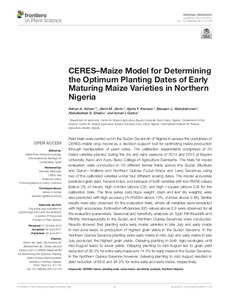| dc.contributor.author | Adnan, A.A. |
| dc.contributor.author | Jibrin, J. M. |
| dc.contributor.author | Kamara, A. |
| dc.contributor.author | Abdulrahman, B.L. |
| dc.contributor.author | Shaibu, A.S. |
| dc.contributor.author | Garba, I.I. |
| dc.date.accessioned | 2019-12-04T11:08:48Z |
| dc.date.available | 2019-12-04T11:08:48Z |
| dc.date.issued | 2017-06-28 |
| dc.identifier.citation | Adnan, A.A., Jibrin, J.M., Kamara, A., Abdulrahman, B.L., Shaibu, A.S. & Garba, I.I. (2017). CERES-Maize model for determining the optimum planting dates of early maturing maize varieties in Northern Nigeria. Frontiers in Plant Science, 8(1118), 1-14. |
| dc.identifier.issn | 1664-462X |
| dc.identifier.uri | https://hdl.handle.net/20.500.12478/1915 |
| dc.description | Open Access Journal |
| dc.description.abstract | Field trials were carried out in the Sudan Savannah of Nigeria to assess the usefulness of CERES–maize crop model as a decision support tool for optimizing maize production through manipulation of plant dates. The calibration experiments comprised of 20 maize varieties planted during the dry and rainy seasons of 2014 and 2015 at Bayero University Kano and Audu Bako College of Agriculture Dambatta. The trials for model evaluation were conducted in 16 different farmer fields across the Sudan (Bunkure and Garun—Mallam) and Northern Guinea (Tudun-Wada and Lere) Savannas using two of the calibrated varieties under four different sowing dates. The model accurately predicted grain yield, harvest index, and biomass of both varieties with low RMSE-values (below 5% of mean), high d-index (above 0.8), and high r-square (above 0.9) for the calibration trials. The time series data (tops weight, stem and leaf dry weights) were also predicted with high accuracy (% RMSEn above 70%, d-index above 0.88). Similar results were also observed for the evaluation trials, where all variables were simulated with high accuracies. Estimation efficiencies (EF)-values above 0.8 were observed for all the evaluation parameters. Seasonal and sensitivity analyses on Typic Plinthiustalfs and Plinthic Kanhaplustults in the Sudan and Northern Guinea Savannas were conducted. Results showed that planting extra early maize varieties in late July and early maize in mid-June leads to production of highest grain yields in the Sudan Savanna. In the Northern Guinea Savanna planting extra-early maize in mid-July and early maize in late July produced the highest grain yields. Delaying planting in both Agro-ecologies until mid-August leads to lower yields. Delaying planting to mid-August led to grain yield reduction of 39.2% for extra early maize and 74.4% for early maize in the Sudan Savanna. In the Northern Guinea Savanna however, delaying planting to mid-August resulted in yield reduction of 66.9 and 94.3% for extra-early and early maize, respectively. |
| dc.format.extent | 1-14 |
| dc.language.iso | en |
| dc.subject | Planting Date |
| dc.subject | Agronomic Practices |
| dc.subject | Agricultural Research |
| dc.subject | Ceres–Maize |
| dc.subject | Early Maize |
| dc.subject | Sensitivity Analysis |
| dc.subject | Northern Nigeria |
| dc.title | CERES-maize model for determining the optimum planting dates of early maturing maize varieties in northern Nigeria |
| dc.type | Journal Article |
| dc.description.version | Peer Review |
| cg.contributor.crp | Maize |
| cg.contributor.affiliation | Bayero University |
| cg.contributor.affiliation | International Institute of Tropical Agriculture |
| cg.coverage.region | Africa |
| cg.coverage.region | West Africa |
| cg.coverage.country | Nigeria |
| cg.isijournal | ISI Journal |
| cg.authorship.types | CGIAR and developing country institute |
| cg.iitasubject | Agronomy |
| cg.iitasubject | Maize |
| cg.journal | Frontiers in Plant Science |
| cg.howpublished | Formally Published |
| cg.accessibilitystatus | Open Access |
| local.dspaceid | 85033 |
| cg.targetaudience | Scientists |
| cg.identifier.doi | https://doi.org/10.3389/fpls.2017.01118 |

